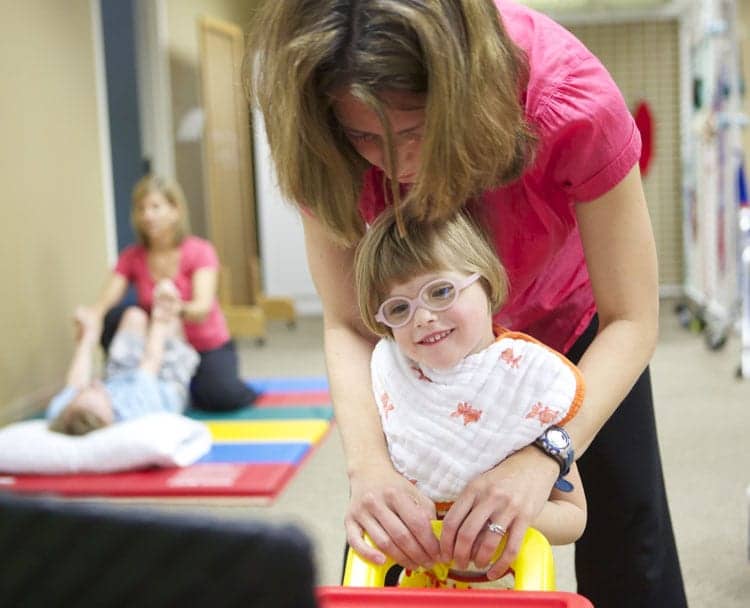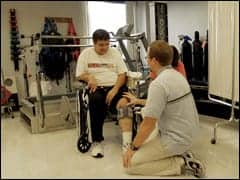By Shannon La Spina, PT, DPT

The Benefits of Pediatric Strength Training
Historically, most children who are treated in physical therapy are seen on a weekly basis, which allows less time to prepare the body for functional training, and less time to focus on specific tasks. While needing further investigation and larger sample sizes, research about the outcomes of the intensive model of therapy is promising. Carr et al showed improved GMFM-88 and GMFM total mean scores following intensive therapy sessions for 20 children.2 Bar-Haim et al found greater improvement than would be expected of natural maturation, after treatment with the Adeli suit versus neurodevelopmental treatment-based therapy during an intensive session.3 Research literature also is increasingly describing the benefits of strength training in children with cerebral palsy, and the benefits of short intensive bouts of therapy, versus the traditional model.4
Intensive therapy offers the therapist several benefits, including time to prepare a child for therapy, the ability to home in on specific targeted muscle groups, and opportunity to strengthen with a specific functional goal in mind. With consecutive days in therapy, the PTs can build on gains made daily and achieve the next level of function, whether it is rolling over or taking independent steps. This therapy model is also a good option to use when a child has reached a plateau in traditional therapy, or after another intervention has been used (eg, Botox injections, serial casting) to maximize a child’s newly acquired range of motion.
Meeting a Need
Bon Secours RHTC was created to meet a need for intensive physical therapy services, and is located in the western suburbs of Richmond. Established by Cindy Richards, MSPT, in 2006, it has become a growing clinic serving approximately 80 children in intensive therapy (often multiple sessions) a year, as well as 40 children in regular outpatient therapy a year. Patients are seen at the clinic under three models: intensive, modified intensive, and outpatient.
Intensive sessions run for 3 or 4 weeks, for 3 to 4 hours a day, 5 days per week. The time frame and length of daily time in therapy vary based on the child’s tolerance, medical issues, and what the family can logistically handle. Modified intensive sessions are used for those children who cannot tolerate the intense daily model. Modified intensive sessions typically run for 3 months, 2 hours per day, 3 days per week. Outpatient sessions vary between 1 and 2 hours, one to two times per week, depending on the needs and tolerance level of the child. Patients often come for outpatient sessions in between intensive sessions, depending on where they live. With some families traveling from other cities—and sometimes even from other states—some children receive outpatient therapy elsewhere and come to RHTC only for intensive sessions.
While in intensive sessions, children have several options for accommodating the school hours they will miss. Some families choose to center therapy around summer break, or have at least 1 week of the session scheduled during spring or Christmas break, while some children attend school for one half of the day and attend therapy the other half. Also, some children utilize homebound instruction while in therapy.
Started as a private practice, the clinic is in its third location and was acquired by Bon Secours Richmond Health System in May 2012; it is a part of the Bon Secours Medical Group. Richards started the clinic to serve an unmet demand in the greater Richmond, and Virginia, area. When asked what motivated her to start the practice, Richards states, “I knew that I wanted to make a difference in the children’s lives that I see every day, and I didn’t always feel that I was doing that in weekly therapy sessions. After much encouragement from families who had been traveling out of state to receive the intensive therapy model, and a lengthy discernment process, I eventually found the courage to investigate the possibility of opening a clinic in Richmond.
“I traveled to Atlanta to see a patient in her intensive therapy session, and I had an opportunity to observe the treatment and interview the staff. The more I learned, the more I liked what I saw. It just seemed logical that more time to properly prepare the children for exercises, then target the exercises, and then translate the newfound strength into function were what I had been missing in my treatment in the past. The increased frequency and duration is what this population really needs to show improvements. I went for training in Michigan, and I learned the science behind the increased frequency and duration that really made the difference. When I returned to Richmond and implemented this intensive therapy model, the changes that I began to see in the children were astounding.”
Richards further states, “My first intensive patient was a two and a half-year-old who had significant gross motor delays and was undiagnosed at the time. She was nonverbal, had global low tone, developmental delay, and lack of coordination, and was able to move around on the floor with an atypical pattern of crawling, not a reciprocal creeping pattern, prior to intensive therapy. With the increased frequency and duration of the intensive therapy program, she was able to have the repetition she needed to help her with motor planning, so that she was not only able to crawl with a more typical gait pattern, but was even able to negotiate up four stairs, which she had never accomplished before.”
A Growing Foundation for Intensive Pediatric Physical Therapy
The staff at RHTC, six physical therapists strong and growing, all have backgrounds and training in pediatrics and serve a wide variety of patient diagnoses and ages. Children range in age from infants to early twenties, and present with a range of impairments, from mild to severe. On a busy day, the clinic serves 15 to 20 children with both orthopedic and neurological deficits. A typical intensive session begins with 30 minutes of heat, active stretching, and soft tissue massage to tight muscles. This is often done in conjunction with therapeutic positioning or upper extremity exercises. Interventions then move to strengthening the core and extremities, primitive reflex integration exercises, transfer and functional mobility training, specified muscle group training using a universal exercise unit, and standing or gait training using appropriate assistive devices. Other equipment available includes a treadmill, a partial weight-bearing gait training system, toys and books, therapeutic swing, adaptive bikes, trial braces and orthotics, compression garments for children with special needs, balance equipment, electrical stimulation, hot and cold packs, therapy balls, benches of varying heights, therapeutic tape, and a therapy suit.
The therapy suit is used as an extension of a therapist’s arms. The suit works to achieve compression across many joints, and increase awareness of the core muscles that allow postural control and progression through normal patterns of movement and motor development. The joint compression suit increases the child’s sensory input, provides increased information to the brain regarding body position, and allows strengthening exercises and functional mobility training with the body in proper alignment.
Establishing Funding
Until January 2013, RHTC was a cash-based practice, not taking insurance but many families submitted codes on their own accord. Virginia is one of two states (Florida being the other) in the nation to have a state-run birth injury fund, which assists in therapy coverage for those children enrolled. Since the center started billing insurance providers, claims are submitted to private insurance and Medicaid in addition to the birth injury fund.
Sarah Ann Jennings, the center’s operations coordinator, points out, “The challenge of accepting insurance and Medicaid for intensive therapy services goes back to the base problem facing all therapies for children with special needs: in the insurance world, they treat a child with a lifelong disability the same as they do an adult patient with a shoulder injury. Many plans strictly limit the number of services per year, and even the number of units that can be billed for a particular day.”
Jennings continues, “Because of hospital contracts with individual payors, it is not unusual for us to treat for 3 hours knowing we will be reimbursed for only 1 hour. Add this to the low reimbursement rate experienced by physical therapy services across the board, and it creates a challenge to remain profitable while providing what we know to be the best care and treatment plan for the children in our care.”
The staff at Bon Secours Richmond Hope Therapy Center strives to bring hope to the forefront of the therapy experience, through dedication to their craft and a continuing quest to take patients to the next level of excellence. Through creative, playful, and innovative techniques, while working closely with families, physicians, and equipment vendors, children are encouraged to make functional gains, and then reach for the next level. RM
Shannon La Spina, PT, DPT, is a staff physical therapist at Bon Secours Richmond Hope Therapy Center, Glen Allen, Va. Specializing in orthopedics and gait analysis, she is a member of the American Physical Therapy Association and an APTA credentialed clinical instructor. She is a graduate of the Medical College of Virginia at Virginia Commonwealth University, and a VA-LEND (Leadership Excellence in Neurodevelopmental Disabilities) fellow. For more information, contact [email protected].
References
1. TheraSuit. http://www.suittherapy.com/
2. Carr P, Kolobe TA, O’Connell L, Williams S. Effects of an intensive therapy protocol on children with cerebral palsy. Abstracts of Presentations for 2006 Combined Sections Meeting. Pediatr Phys Ther. 2006;18:73.
3. Bar-Haim S, Harries N, Belokopytov M, et al. Comparison of efficacy of Adeli suit and neurodevelopmental treatments in children with cerebral palsy. Dev Med Child Neurol. 2006;48:325-330.
4. Damiano DL. Rehabilitative therapies in cerebral palsy: the good, the not so good, and the possible. J Child Neurol. 2009;24(9):1200-1204.





